Look ra, look Pa no source resistor (well sort of)!
I had these Hammond 193U chokes, series resistance 1R7 and thought why not?
Sim is 1W, 3W, 5W.
Shot for 18 or so volts across the SIT. 3V or so across the choke... 21.3V in does the trick.
The only adjusment is the power supply voltage using Mark's Tuba boards.
Easiest amplifier build yet and it sounds great. Transparent and with what I call organic bass.
Thanks ra7 👍
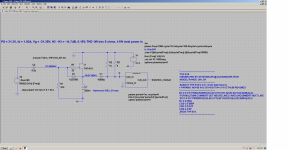
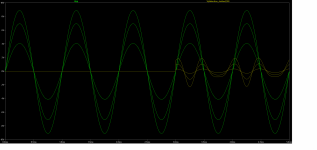
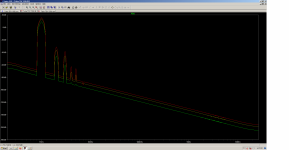
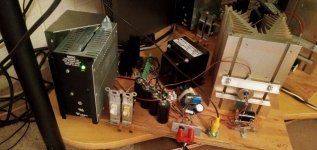
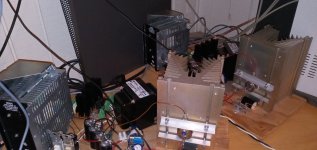
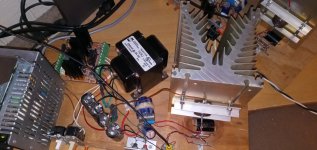
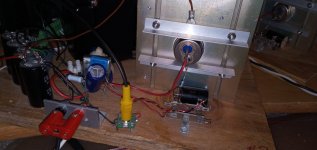
I had these Hammond 193U chokes, series resistance 1R7 and thought why not?
Sim is 1W, 3W, 5W.
Shot for 18 or so volts across the SIT. 3V or so across the choke... 21.3V in does the trick.
The only adjusment is the power supply voltage using Mark's Tuba boards.
Easiest amplifier build yet and it sounds great. Transparent and with what I call organic bass.
Thanks ra7 👍







Love that. Awesome build. Even simpler with no resistor. Totally agree about organic bass. The thing I have not heard on any other amp so far is the resolving of bass decay sounds and resonances. It tells you the full flavor of the instrument and how skillfully it is being played.
I see that you went with a negative supply and drain grounded, Papa recommended!
I am planning a big TDV with the 193V and may end up with no resistors either.
I see that you went with a negative supply and drain grounded, Papa recommended!
I am planning a big TDV with the 193V and may end up with no resistors either.
Actually built with a positive supply because that's what the regulator boards are. Noise is very low though.
When I build into chassis, I may look into designing a negative version of Mark's Tuba... abuT?
193V only 1 ohm. 🤔
When I build into chassis, I may look into designing a negative version of Mark's Tuba... abuT?

193V only 1 ohm. 🤔
That looks like quite a big heatsink. If your power supply is capable, and the THf-51S is certainly capable, you can run even higher voltage. I run my 193V loaded 2SK180 follower at Vds=35V, Iq=2.5A and it sounds great.
I have V+ also and I don't hear any noise from my 103dB speakers.
I think all SIT followers have great sound. 🙂
I have V+ also and I don't hear any noise from my 103dB speakers.
I think all SIT followers have great sound. 🙂
Yeah, lower DC resistance means higher bias current. So, with the right choke and enough heatsink, you could go resistor-less.193V only 1 ohm. 🤔
Hmm... only change is choke to the 193V and nothing else and presto-change-o... 3A bias. Sim is 1W, 3W, 5W, 10W 😎
Too bad my power supply can't handle it, plus Mark's Tuba regulator would need bigger heat sink too.
Pros: more power out, better harmonic distortion profile (more H2, less H3), easy THF-51S amp build.
Cons: THD 2x more at 1W, chokes weigh 3 lbs. more each (ouch my back!), about 50% more power consumption, 193V now $103 each (ouch my wallet!).
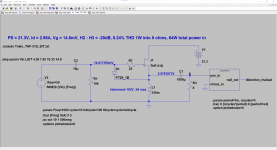
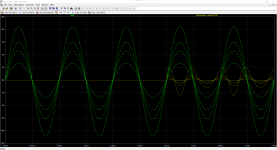

Too bad my power supply can't handle it, plus Mark's Tuba regulator would need bigger heat sink too.
Pros: more power out, better harmonic distortion profile (more H2, less H3), easy THF-51S amp build.
Cons: THD 2x more at 1W, chokes weigh 3 lbs. more each (ouch my back!), about 50% more power consumption, 193V now $103 each (ouch my wallet!).



Great sims Cinco! Yeah, higher voltage might yield better results but will also cost you on the heatsink. But the great benefit is more power 
My little TDV was not enough in the Burning Amp space, which was about three times my home space. If 5W is all you’ll ever need, don’t bother with the higher power. But if your speakers crave more power, then this is an option. The Tokins can certainly take the heat.
Also, the TDV topology is the most efficient and has the lowest heatsinking and PS requirements out of all the other options (resistor, light bulb, CCS, and Muff).

My little TDV was not enough in the Burning Amp space, which was about three times my home space. If 5W is all you’ll ever need, don’t bother with the higher power. But if your speakers crave more power, then this is an option. The Tokins can certainly take the heat.
Also, the TDV topology is the most efficient and has the lowest heatsinking and PS requirements out of all the other options (resistor, light bulb, CCS, and Muff).
Seeing how Ben Mah has inverted his power supply - using a negative voltage to the source (through the choke) - I assume this should be able to be done with TDV. What do you think about doing this, ra7?
And If I may revisit a tiresome question again - in the interests of SCG board real estate wouldn't it be the same if I place the SCG's output cap at the input of the TDV? I was going to delete the input cap of TDV bit it would be far easier to place a cap there instead of on the SCG board.
I am going to use the CDE 940 and they are very large.
Thanks and take care,
And If I may revisit a tiresome question again - in the interests of SCG board real estate wouldn't it be the same if I place the SCG's output cap at the input of the TDV? I was going to delete the input cap of TDV bit it would be far easier to place a cap there instead of on the SCG board.
I am going to use the CDE 940 and they are very large.
Thanks and take care,
And boom, there you have it. That’s how I would do it too. Thanks Ben!
If you have a big choke, like the 193V, and a big sink or active cooling, you could drop R3 altogether. But this should be done very carefully. Cinco ran sims earlier and with an Rdc of 1 ohm for the choke, it came right in the 3.0A zone. But it needs to be tested for stability. And you want to definitely ramp up the supply with a Variac and keep an eye on the current as you bring up the voltage.
As for the cap, you could eliminate the cap on the SCG if it is in the same chassis as the power amp. Otherwise you are transferring 60V or so across an RCA cable. Plus you’d need to remember that the SCG does not have a cap if you ever want to use it somewhere else. I know I would forget it.
I am finding that caps in the signal path do have a sound but a good polyprop does the job and stays out of the way. The Dayton polys are great. Don’t worry about it too much.
Edit: 193V chokes are on the way. Give me a few days and I can report back on how it does with the big chokes.
If you have a big choke, like the 193V, and a big sink or active cooling, you could drop R3 altogether. But this should be done very carefully. Cinco ran sims earlier and with an Rdc of 1 ohm for the choke, it came right in the 3.0A zone. But it needs to be tested for stability. And you want to definitely ramp up the supply with a Variac and keep an eye on the current as you bring up the voltage.
As for the cap, you could eliminate the cap on the SCG if it is in the same chassis as the power amp. Otherwise you are transferring 60V or so across an RCA cable. Plus you’d need to remember that the SCG does not have a cap if you ever want to use it somewhere else. I know I would forget it.
I am finding that caps in the signal path do have a sound but a good polyprop does the job and stays out of the way. The Dayton polys are great. Don’t worry about it too much.
Edit: 193V chokes are on the way. Give me a few days and I can report back on how it does with the big chokes.
Thanks to the both of you. I cannot help but mention you Ben Mah! And will continue to.
Yes, I will start with more resistance than I think I would need and work down - good way to see the trend and be able to extrapolate.
Iwill be using the LUNDAHL LL2733 so 3 amps is probably a good place to stop.
ra7, thanks for your advice. The SCG and the Singin' Bush now TDV will be less than three cable feet away from each other.
My system is truly a system - nothing gets moved about and nothing is ever substituted and the components are not used anywhere else so I am not worried about the stage being used anywhere else. As I approach the day of my final reckoning I will put a note on it!
60 volts on the cable is to be respected. I think the connectors on the cables would be the most concerning - I will most likely not use any connectors and solder my DIY cables directly to each component. The way my amplifiers are configured it would be very simple to solder tha cable to the TDVs. I hate connectors in general and try to minimize them - usually using them on only one end. But this will be a special case.
Got my TOROIDY transformer yesterday. I ordered two but got one. I thought the price was too good to be true and sure enough it was. A very jewel like thing as it should be for two hundred dollars. Very large in size for the power rating. Must be plenty of potting in the stainless steel enclosure. About two weeks to receive. I will have to get another one.
It is not that I have a capacitor phobia but I hate to spend the money. My surname should give me away. Nonetheless money saved on superfluous caps can be used for better caps. Not insane caps, by the way.
Yes, I will start with more resistance than I think I would need and work down - good way to see the trend and be able to extrapolate.
Iwill be using the LUNDAHL LL2733 so 3 amps is probably a good place to stop.
ra7, thanks for your advice. The SCG and the Singin' Bush now TDV will be less than three cable feet away from each other.
My system is truly a system - nothing gets moved about and nothing is ever substituted and the components are not used anywhere else so I am not worried about the stage being used anywhere else. As I approach the day of my final reckoning I will put a note on it!
60 volts on the cable is to be respected. I think the connectors on the cables would be the most concerning - I will most likely not use any connectors and solder my DIY cables directly to each component. The way my amplifiers are configured it would be very simple to solder tha cable to the TDVs. I hate connectors in general and try to minimize them - usually using them on only one end. But this will be a special case.
Got my TOROIDY transformer yesterday. I ordered two but got one. I thought the price was too good to be true and sure enough it was. A very jewel like thing as it should be for two hundred dollars. Very large in size for the power rating. Must be plenty of potting in the stainless steel enclosure. About two weeks to receive. I will have to get another one.
It is not that I have a capacitor phobia but I hate to spend the money. My surname should give me away. Nonetheless money saved on superfluous caps can be used for better caps. Not insane caps, by the way.
2SK180s mounted on the chassis. Sheet metal was finished by Send Cut Send and I scrounged most of the hardware from my work. I decided to do something a bit different and make a vertical amp for a change.
Attachments
-
 68876F71-C56F-48DB-970A-F491739B6F61.jpeg349.8 KB · Views: 139
68876F71-C56F-48DB-970A-F491739B6F61.jpeg349.8 KB · Views: 139 -
 213A75EA-23C4-4228-9C68-35E56FF6259D.jpeg818.9 KB · Views: 144
213A75EA-23C4-4228-9C68-35E56FF6259D.jpeg818.9 KB · Views: 144 -
 9F5889BC-DFDA-45D2-A279-D93806409946.jpeg364.1 KB · Views: 142
9F5889BC-DFDA-45D2-A279-D93806409946.jpeg364.1 KB · Views: 142 -
 9EBBADF1-4957-425D-AAB1-1E2AB7BC8588.png239.2 KB · Views: 148
9EBBADF1-4957-425D-AAB1-1E2AB7BC8588.png239.2 KB · Views: 148 -
 19533746-5389-44D6-8EA0-A50A1DA1EFCA.jpeg406.9 KB · Views: 138
19533746-5389-44D6-8EA0-A50A1DA1EFCA.jpeg406.9 KB · Views: 138
First class packaging. I wonder if you have anywhere near enough heat sink, though.
Given the way that the finned heat sinks are attached to the larger aluminum front plate, which is attached to the side L-brackets, there may be just enough total area to keep the SITs at a reasonable temperature.
Those devices are pretty robust. The proof will be uncovered once the bias current is set.
It is a fairly novel approach to the chassis. I am rooting in favor of it working.
Those devices are pretty robust. The proof will be uncovered once the bias current is set.
It is a fairly novel approach to the chassis. I am rooting in favor of it working.

No fans, trying to keep it passive. I’m not running the SITs very hot, about 40W each at most. They seemed to be ok temp-wise when the sinks weren’t mounted. I’m hoping it works out 😁. Thanks for the kind words.I thought he has fans in there somewhere. Very cool and unique approach
Papa’s do it by the hand approach is very effective. If you touch the sinks and can’t keep your hand on it for more than 5 seconds, it is probably not enough heatsink. The hand has a non-linear relationship with temperature. It goes:
Warm
Hot
Hotter
Whoa, that’s hot

You want to not go to that last step 😆
Warm
Hot
Hotter
Whoa, that’s hot

You want to not go to that last step 😆
- Home
- Amplifiers
- Pass Labs
- Total Domination VFET (TDV) Amp (using 2SK2087C)
